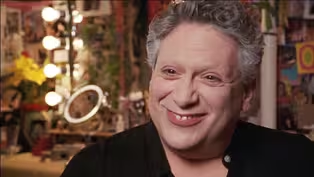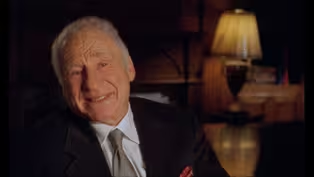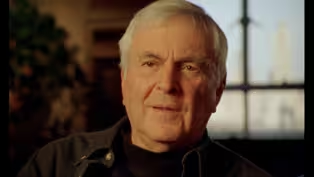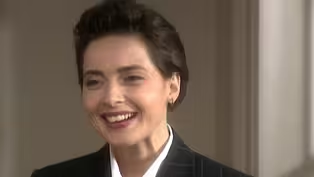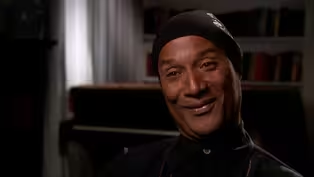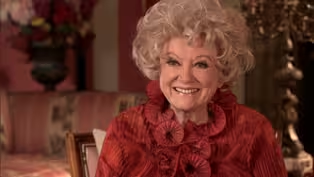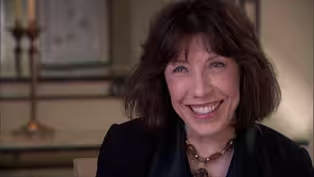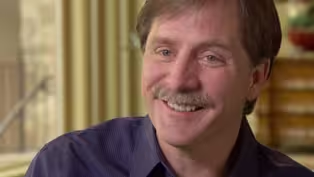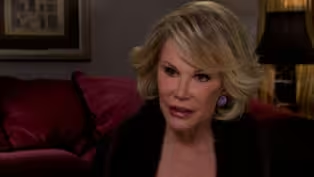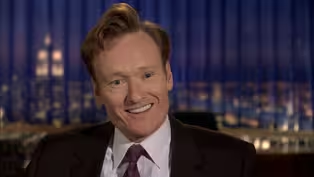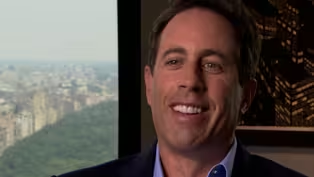
Quincy Jones explains how he got started in music
Special | 15mVideo has Closed Captions
Quincy Jones discusses his early career, friendships and how he defines himself.
On July 24th, 2001, Quincy Jones sat down with Michael Kantor, director of "American Masters — Quincy Jones: In The Pocket" (2001), to discuss Jones' early career, his friendships with Miles Davis and Frank Sinatra, and how he defines himself and a fulfilling life.
Problems playing video? | Closed Captioning Feedback
Problems playing video? | Closed Captioning Feedback
Support for American Masters is provided by the Corporation for Public Broadcasting, AARP, Rosalind P. Walter Foundation, Judith and Burton Resnick, Blanche and Hayward Cirker Charitable Lead Annuity Trust, Koo...

Quincy Jones explains how he got started in music
Special | 15mVideo has Closed Captions
On July 24th, 2001, Quincy Jones sat down with Michael Kantor, director of "American Masters — Quincy Jones: In The Pocket" (2001), to discuss Jones' early career, his friendships with Miles Davis and Frank Sinatra, and how he defines himself and a fulfilling life.
Problems playing video? | Closed Captioning Feedback
How to Watch American Masters
American Masters is available to stream on pbs.org and the free PBS App, available on iPhone, Apple TV, Android TV, Android smartphones, Amazon Fire TV, Amazon Fire Tablet, Roku, Samsung Smart TV, and Vizio.
Buy Now
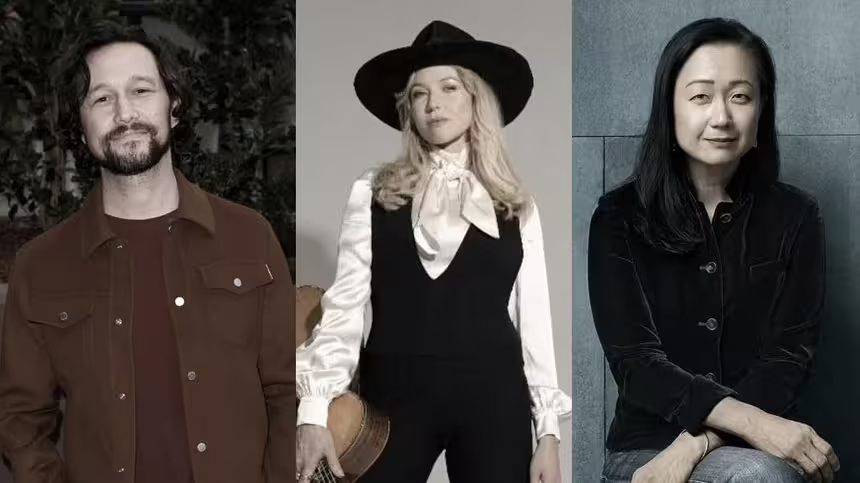
A front row seat to the creative process
How do today’s masters create their art? Each episode an artist reveals how they brought their creative work to life. Hear from artists across disciplines, like actor Joseph Gordon-Levitt, singer-songwriter Jewel, author Min Jin Lee, and more on our podcast "American Masters: Creative Spark."Providing Support for PBS.org
Learn Moreabout PBS online sponsorshipMore from This Collection
Watch curated interviews from The American Masters Digital Archive. The full collection includes over 1,000 hours of never-before-seen, raw interviews: a treasure trove of the movers and shakers of American culture, including Maya Angelou, Patti Smith, Mel Brooks, Carol Burnett, Matthew Broderick, Carl Reiner, Joan Rivers, Dionne Warwick, Lee Grant, Sidney Lumet, Betty White and many others.
Harvey Fierstein on gay representation on Broadway and its deep history
Video has Closed Captions
Harvey Fierstein talks to director Michael Kantor backstage during the production of "Hairspray." (13m 8s)
Video has Closed Captions
Ringo Starr describes his friendship with Mae West. (10m)
Mel Brooks' wild ride to his first Broadway show ever
Video has Closed Captions
Mel Brooks talks about the first Broadway show he ever saw—Cole Porter's "Anything Goes." (5m 44s)
John Kander and Fred Ebb on “Cabaret,” creativity and collaboration
Video has Closed Captions
Composer John Kander and lyricist Fred Ebb talk about how they have worked together. (5m 56s)
Isabella Rossellini compares her acting and modeling
Video has Closed Captions
Isabella Rossellini discusses her acting versus modeling career. (28m 24s)
Paul Mooney on his career and relationship with Richard Pryor
Video has Closed Captions
Paul Mooney reflects on the mechanics of stand-up and his role as Richard Pryor's best friend. (10m 39s)
How Phyllis Diller broke down the doors for female comics
Video has Closed Captions
Phyllis Diller reflects on how her comedy was a response to years of “take my wife” jokes. (11m 35s)
How Lily Tomlin found liberation in exploring her Laugh-In characters
Video has Closed Captions
Lily Tomlin speaks about her time on Laugh-In and how she developed her characters. (12m 35s)
Jeff Foxworthy on how every American might be a "redneck"
Video has Closed Captions
Jeff Foxworthy discusses regionalism in comedy and why "redneck" is a state of mind. (15m 41s)
Joan Rivers finds humor in being yourself
Video has Closed Captions
Joan Rivers speaks about her experience as a female comic in the early 60s. (9m 59s)
Conan O’Brien gets serious about silliness
Video has Closed Captions
Conan O’Brien speaks about his style of late night and his reason for doing comedy. (15m 32s)
Jerry Seinfeld on his place in American sitcom history
Video has Closed Captions
Jerry Seinfeld discusses his collaboration with Larry David and the evolution of the sitcom. (16m 1s)
Providing Support for PBS.org
Learn Moreabout PBS online sponsorship- Our first job, my first job, professional job, 1947 at the Madison Avenue Y and we had four horns.
And with Charlie Taylor, who started the band, myself, Eddie Beard and Oscar Holden, his sister Grace Holden, and my brother Wayman on drums.
Now, Wayman was not born to be a drummer, you know?
He wanted to play drums, but he was not born to be a drummer 'cause Wayman in the history of jazz, nobody has ever stopped in the middle of a tune.
And Wayman would chew gum when he played drums.
And we playing "Choo-Choo Ch'Boogie" with Louis Jordan and all of a sudden, man.
♪ Choo-choo ch'boogie" ♪ Bam, stops.
Looking back, Wayman's blacked out.
I said, "What's wrong?"
He said, "I'm tired."
(laughing) Please, man.
Wayman's beautiful.
I adore him, man.
Bumps Blackwell was like a legend in Seattle.
You know, you couldn't get away from him.
He ran a butcher shop on Madison Avenue under the Washington Educational Social Club.
He had a chain of taxi cabs.
He worked in a jewelry store.
He had a job at Boeing and he had a junior and a senior band.
So we heard about the senior band.
He was like a, you know, he owned the turf.
And so, he saw Charlie Taylor's band and sort of drafted that into being Bumps Blackwell's junior band.
And before we know it, we look up, we're opening for Cab Calloway, 'cause we could do everything.
Dance, sing, play together, comedy, anything at 13 years old.
And we'd open for Cab Calloway, Bobby Tucker comes through, we work with Billie Holiday, comes back through with Billy Eckstine.
We worked with Billy Eckstine.
So, you know, we felt we were hot stuff, you know, and Ray Charles is in town.
And it was wonderful, 'cause we were just pumped up all the time.
And we had three jobs a night, you know, and it was great for kids.
It's a miracle.
We used to play hooky from school, oh, every day of the week.
Sometimes, you know, to go down to pay 11 cents to go see these movies.
And I was more interested in, 'cause I don't know where this fascination for visual and sound came from, but I could feel the influences of all the studios after a while, after listening to so many with Alfred Newman at Fox and Victor Young at the Paramount, et cetera, et cetera.
Benny Carter, whenever he did something, and Horace Henderson with Lena Horne.
But after a while, I didn't think it was ever gonna be possible for me to get the, to get an opportunity to write for films, because they were long four-syllable Eastern European names most of the time.
And not too many Joneses or Johnsons on there.
So... (chuckles) You know, they say God protects fools and babies, right?
(chuckles) I was so stupid when I was young at this age, but I had so much passion for music.
I didn't know what key signatures were.
I hadn't studied formally.
And so, I'd write on notes at the top of the parts, play B natural, a half step lower.
'cause it sounds funny if you play it natural.
And the guy said, "Just put a flat down it in the center key of F, turkey."
(chuckles) And I was trying to describe the western winds, and the north winds, and the southern winds, and the different characteristics of it, 'cause I always wanted to write for movies first.
So I always thought visually.
And eventually, I went for it, wrote it.
We played it at Seattle University with Gustman Hertz Orchestra.
And I showed it to Lionel Hampton and that helped get me outta Seattle.
Well, before that, I sent it to Boston, which is called the Schillinger House, which is now Berkeley School of Music.
And that've got me to the East Coast, closer to Charlie Parker and Bird, (chuckles) and Miles.
Since I think I could even hold my horn properly, I wanted to, and tried to play like Miles Davis.
Dizzy was too hard to imitate.
(laughs) And Miles was so cool.
And he changed the sound of the trumpet.
He's the Picasso of jazz.
He really is.
He went through just like the "Blue" and the cubism, and primitive, and everything else.
So Miles did exactly the same thing and not followed it.
He led it.
He led all the movements he went through.
And I finally got to meet him in 1951.
I was standing in the Downbeat Club in the yard.
Scared to death and wide-out eyed Seattle green turkey.
I listened to Mingus and up behind, he said, "I heard some sucker from Lionel Hampton record trying to sound like me."
I said, "Oh my God, (chuckles) no."
And behind me it was Miles.
And he wanted to let me know that it was his way of saying hello in a way, you know?
And we were friends until he left, you know.
He was incredible.
Well, this was the first professional thing I've ever had recorded, and I was so proud, and I was levitating.
It was called "Kingfish".
And I wrote the arrangement, I wrote the tune, and I did probably one of my only solos on record.
That's the first thing I recorded with Lionel Hampton, but I didn't have much money.
So somebody told me, the way you copyright it is, put it in an envelope and seal it, and put "Not to be open for copyright."
So they stamp it on the back.
They put the stamps on the back and that will hold up in court.
And so, thank God somebody, (chuckles) again, showed you the way and showed you how to protect your music.
And I was thrilled when we did this.
This was 1951.
Well, I had been on the road for years with Lionel Hampton.
I'm coming outta Seattle, and I got a lot of surprises in the South, but, you know, with colored drinking fountains, and that's what they say, colored and white, and the dance halls were all segregated in New Orleans, Mississippi, and Georgia, and everywhere.
And we are in the '60s now, '64.
And so, when we first met, we get there, Frank [Sinatra] has this big huddle over there, some slot machines.
I remember Keely Smith and her brother Peggy were there.
And I see a bunch of very rough-looking dudes standing around.
He says, "Here's how it's gonna work.
Each one of you guys are gonna be assigned to a different guy in the band.
And if anybody even looks funny at him, break their legs."
(laughs) I mean, Frank used that word very loosely.
(laughs) And I had a Yugoslavian dude, you know, in his late 60s with a bald head they could actually break a brick, you know, probably with his hands.
He taught me to speak Serbo-Croatian, and I didn't realize it was that rough up there then.
And they'd just come out of a situation where, you know, the biggest artist up there, whether it be Nat Cole or Lena, or anybody else.
They had to eat in the kitchen.
They could not even go into the casino.
Sammy Davis couldn't go in the casino when he first worked there.
That's the way it was.
And I remember once with the Four Tops were working with Sammy, and they weren't allowed to go in the pool.
And somebody made a crack up about, "What are you talking about?
Is there gonna be a ring around the pool or something?"
But it was racist.
There's no two ways about it.
And that's the way it was.
It's the family ring of the Sinatra family.
This is the ring of the Frank Sinatra wore where almost everything he's sang.
And Tina gave us all rings with this family seal on it, the people that were really close to the family.
It means a lot to me.
Frank was amazing.
We bonded an amazing way.
I never took it, unfortunately.
I never knew how real and deep it was until he was gone, because I didn't want to take the chance of being too vulnerable enough to get hurt if that was the way he acted with everybody, you know what I mean?
But he really reached out.
He asked me to go to the family dinners on Thanksgiving and Christmas.
And we spent a lot of time together, really hanging in Palm Springs and just incredible working and playing relationship.
And either one is 100% experience playing with him and working with him, but working and playing with him is awesome.
And I'm glad I did both.
I think what made Frank Sinatra so great, it was the same thing that made people like Ella Fitzgerald and Billy Eckstine, Sarah Vaughan, and Peggy Lee great.
It's very difficult for the audience today to realize that the bases, the Artie Shaws, the Benny Goodmans and Duke Ellingtons, and Lunsfords, and Tommy Dorseys were the Rolling Stones, and the Beatles, and Boyz II Men, and the Temptations of that time.
The instrumentalists were the stars, you know, and the vocal groups were the relief.
In Tommy Dorsey's band, he'd play as long as he wanted to, and Ziggy Elman and Buddy Rich, and whoever was in the band at that time, and then they'd modulate and Frank Sinatra, Joe Stafford, the Pipers would walk down to the microphone after a modulation, and sing a song, and sit back down.
What made them great is they did not have the pressure on them to be amazing performer, amazing singer, and everything else, because they had a wonderful spawning ground there to sit there every night and learn, listen to the best jazz musicians in the world, and basically Duke's band and watch Tommy Dorsey breathe in "I'm Gettin' Sentimental Over You."
Frank swears, you know, he learned how to breathe and hold notes like he does, because they had the proper apprenticeship time and development, and a spawning ground, a place to use as a spawning ground, which they don't have now.
A kid at 15 years old walks into a studio and gets the number one record.
She's got a publicist, a agent, a manager, pigmies stretches.
Got everything all at one time and $14 million worth of jobs, too.
And has to learn how to do everything that takes somebody else 25 years to develop piece by piece.
They have to get it all together.
Imagine the pressure on Britney Spears.
How many people are there fixing her hair, and her makeup, and the microphone, and the stage, and choreographers, and everything else.
They get her prepared after one or two hits to get out on that stage and hold that spotlight.
It's not easy.
The people from the era Sinatra was singing the best music ever written in America.
(chuckles) Please, let's get real.
They sang the best songs ever written in this country in terms of American popular music.
And I know that's subjective and a matter of opinion, but I mean, when you get down to just music, there's not too much to discuss whether what's really musical and creative lyrically and melodically.
And you must admit that the songs of the 40s and so forth were some of the most powerful things ever written in pop music and most of 'em from Broadway shows.
And they had the best material, they had great arrangers, and very musical bands, and looking back, all those bands were really dance bands, Basically Duke and Artie Shaw, Woody Herman, everything.
They were dance bands first.
The "Shake Your Booty."
Now, in the course of that, with imagination in a group of 18 or 19 musicians, there's a great arranger, there's a great leader, and there's great soloists in there, and a lot of innovation and art came through in spite of it just being a dance situation.
And the classical art came through that, and it was born.
It was like Salk vaccine in a way.
And it came out, and it's something that captured the entire planet very early.
I have a friend in Sweden, Harry Nick Lawson, who was the owner and founder of Jazz Orchestra Journaling.
It's an 80-year-old jazz magazine from Sweden.
And it's ironic that the entire world discovered this art from America.
And Americans to this day, most of them have not really yet understood what place they play in the world of art around the world, American music.
- [Interviewer] Because I ask everyone else to define you.
Who is Quincy Jones?
- I don't know.
I... And whatever I am doing at that time, that's why I always like to explore, and go to that new place and that new adventure to try to find out.
'Cause I figure if you...
I don't ever wanna finish, you know.
I think if you finish, you know, that's when you give up, you know, and I talked to a lot of conductors and so forth.
That's why they live such a long time is because they never get finished.
And they lived, you know, 98 years old.
Or creative people, for the most part, live a long time or should if they don't (chuckles) indulge too much.
But I don't know.
I think that once you develop a core skill, I consider my core skill is arranging and orchestrating, composing.
I mean, that's what I really put all my time into in the beginning.
And I found a way to find a correlation between that and television production, or movies, or magazine, whatever else it is.
You know, you do.
That's what you, you know.
I see a lot of correlation in structure and presentation in the book, you know.
After a while, it's the same thing, you know.
If you have all the trumpets play high for 10 minutes, it's gonna sound like doo-doo, you know?
And it's the same way in a movie, if you have everybody slapping each other, you know, for five reels, you know.
It's about architecture and pacing, and anti-climax and not having anti-climaxes, and establishing a locale, you know, identifying enemies and allies.
I mean, it's story structure.
I'm talking about story structure.
All of those things.
Somehow, they have a common denominator, I feel inside, you know.
And I also feel though that I enjoy following my bliss and my vision.
I trust my vision a lot, you know?
And sometimes with a lot of negative, non-believing people around us saying, "That's not gonna work.
That can't happen."
I don't even think of that.
Doesn't mean a thing to me, 'cause that just makes me recharge and keep going.
And I just love to dream, I love to execute it, I love to be there and try to make some difference in being on this planet, you know?
And I feel very, very, like a very lucky person that I'm able to do all of that and still have the great friends and great children, and you know.
You know, that's all these little pieces of what make all this stuff worthwhile.
I mean, like to say this is what is evidence of you being in your skin, you know?
And most of the time I say, "I don't wanna waste my time sleeping."
(laughs) Was he gonna get a lot of sleep when you get outta here, you know?
And in Frank Sinatra's line, he said, "Live every day like it's the last one."
They could be, right.
(upbeat music) (upbeat music continues)
Support for PBS provided by:
Support for American Masters is provided by the Corporation for Public Broadcasting, AARP, Rosalind P. Walter Foundation, Judith and Burton Resnick, Blanche and Hayward Cirker Charitable Lead Annuity Trust, Koo...
